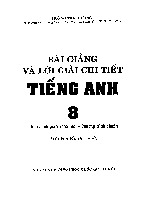

















Preview text:
Unit 1 LEISURE TIME
LESSON 3: A CLOSER LOOK 2 1
LESSON 3: A CLOSER LOOK 2 WARM-UP Warm up: Find someone who…
Verbs of liking / disliking + gerunds PRESENTATION
Verbs of liking / disliking + to-infinitives
Task 1: Work in pairs. Put the verbs in the appropriate column. PRACTICE
Task 2: Choose the correct answer A, B, or C.
Task 3. Look at the pictures and complete the sentences, using
the verbs in brackets in their suitable form.
Task 4: Complete the sentences about yourself. PRODUCTION
Task 5: Game: Likes and dislikes mimes CONSOLIDATION Wrap-up Homework WARM-UP
Go around the classroom and find: Find someone who… Name likes playing computer games. enjoys knitting. Find someone detests cooking. who… fancies going shopping. loves doing puzzles. hates hunting. dislikes watching TV. prefers going to the cinema. PRESENTATION Verbs of liking love prefer like enjoy fancy
Verbs of liking are used to express positive attitudes towards people or things. PRESENTATION Verbs of disliking detest hate dislike
Verbs of disliking are used to express negative attitudes towards people or things. PRESENTATION
• Some verbs of liking and disliking can be
followed by gerunds only.
Example: They dislike surfing the net.
• Some are followed by both gerunds and
to-infinitives.
Example: I love going / to go to the cinema. PRACTICE
1 Work in pairs. Put the verbs in the appropriate column. love like detest fancy dislike enjoy hate prefer Verbs followed by Verbs followed by both gerunds only
gerunds and to-infinitives detest love fancy like dislike hate enjoy prefer PRACTICE
2 Choose the correct answer A, B, or C.
1. I love ______, so in my leisure time, I go to some villages near
Ha Noi to relax and enjoy the outdoors. A. travelling B. travelled C. to travel
2. Tom enjoys ______ puzzles, especially Sudoku. A. doing B. do C. to do PRACTICE
2 Choose the correct answer(s).
3. When do you like ______ TV? A. watched B. watch C. to watch
4. Do you fancy ______ to the cinema this weekend? A. go B. going C. to go
5. I detest ______. I think it’s cruel to harm animals. A. hunting B. to hunt C. hunt PRACTICE
Look at the pictures and complete the sentences, using the verbs in brackets in 3 their suitable form.
1. Mark ________________ likes surfing / to ___ surf ___ the In ___ t __ ernet. (like)
2. The girls ____________. enjoy knitting (enjoy) PRACTICE
Look at the pictures and complete the sentences, using the verbs in brackets in 3 their suitable form. 3. My cousin _____ dislik _____ es c ____ ooking . (dislike) 4. My father____ hat ____ es g ____ oing / ____ to g ______ o shoppi __ ng . (hate) PRACTICE
Look at the pictures and complete the sentences, using the verbs in brackets in 3 their suitable form. 5. Tom and his sister ________________ prefer doing / to ______ do puzzl . es (prefer) PRACTICE
4 Complete the sentences about yourself. All about me I like ______. I dislike ______. I prefer ______. I hate ______. I love ______. I detest ______. PRODUCTION 5
Likes and dislikes mimes
Work in groups. One mimes a leisure activity he / she likes or dislikes.
The others guess the activity by asking yes / no questions using the verbs they have learnt. Example:
A: Do you like surfing the net?
B: No, I don’t.
C: Do you love messaging your friends? B: Yes, I do. CONSOLIDATION 1 Wrap-up
What have we learnt in this lesson?
✓ How to use verbs of liking and disliking CONSOLIDATION 2 Homework Do exercises in the workbook.
Document Outline
- Slide 1
- Slide 2
- Slide 3
- Slide 4
- Slide 5
- Slide 6
- Slide 7
- Slide 8
- Slide 9
- Slide 10
- Slide 11
- Slide 12
- Slide 13
- Slide 14
- Slide 15
- Slide 16
- Slide 17
- Slide 18




